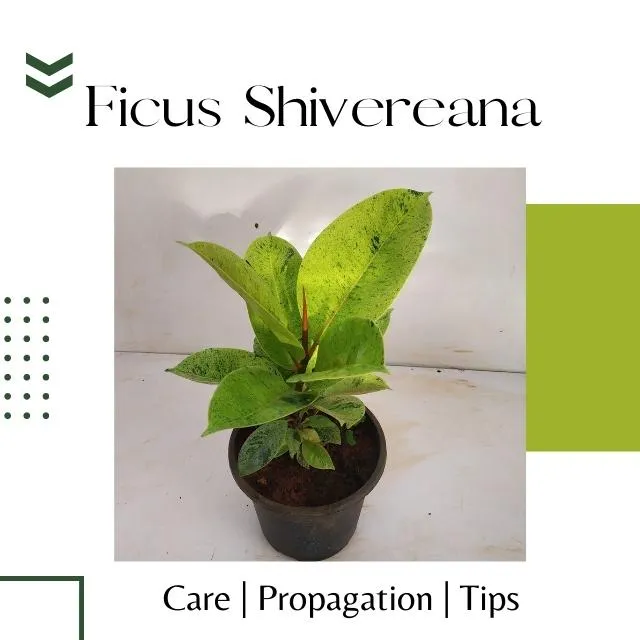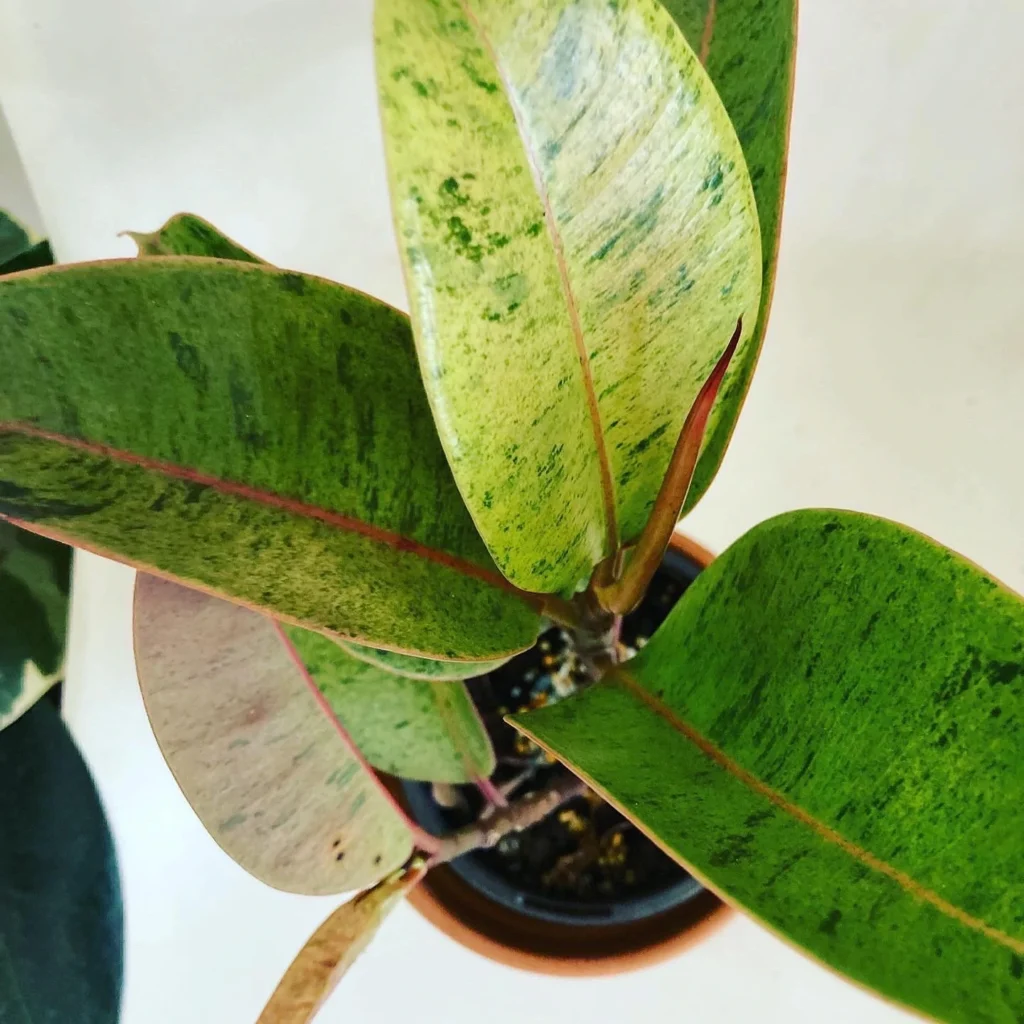Ficus shivereana, also known as the Indian rubber plant, is another half-breed of Ficus elastica. It is named such because its barrel contains 15% rubber. The plant is typically found in the Himalayas the whole way to Malaysia. In nature, these plants grow up to 30-40 meters.
The plant has wide, shiny leaves that are oval and have sharp tips and dark green freckles. The leaves are pinkish-brown in the early stage of growth, though the more seasoned leaves mature into a dark shade of green.
This “rubber” plant develops into an alluring little tree that can fit indoors and take your garden’s style to the next level without much of a stretch. While Ficus shivereana care, in general, is equivalent to other Ficus Elastica types, it is significantly more delicate to settle in new places.
Characteristics of Ficus Shivereana:
Notable characteristics of Ficus Shivereana are as follow.
| Scientific Name | Ficus Shivereana |
| Other Name | Ficus Elastica Shivereana, Variegated Rubber Plant |
| Plant Type | Evergreen / Indoor / Shrub |
| Foliage Colour | Green / Orange / Pink |
| Botanical Genus | Ficus |
| Family | Moraceae |
| Botanical Species | Elastica |

Ficus Shivereana Care
This section explains how to plant your Ficus shivereana and care for it to optimize the growing condition and make it thrive.
Water:
Ficus shivereana, like most variegated plants, prefers to be on the dry side. Let the soil dry before watering it.
The plant is placed in indirect sunlight in a 5-inch pot; it requires 1 cup of water every 9 days.
Temperature:
Temperature is one more essential part of a plant’s development. For your Ficus Shivereana, the suggested temperature range for ideal growth is 15 – 20 degrees Celsius (59F-68F).
Temperatures under 12 degrees Celsius are harmful to the growth of the plant.
Light:
Ample daylight is essential for the growth of Ficus Shivereana. The plant must be positioned in indirect bright light, but away from the direct afternoon sun and away from cold draughts.
Soil:
The best potting mix for Ficus shivereana must have Soil pH between 6.0 and 6.5, and more acidic soil will cause the plant to die.
Beginner plant enthusiasts often underestimate drainage. Unlike underwatering, overwatering causes irreversible damage to the plants.
Also, the soil must have essential nutrients. Loam soils are high in organic matter, which is a fantastic source of nutrients for your Ficus shivereana, and it also helps with drainage.
Fertilizer:
The Ficus will grow just fine without any fertilizer if the soil is well nourished. During the primary growing season, organic fertilizer may be used every month.
Pro-Tip:
Humidity:
Ficus Shivereana is a tough plant and will do well in less humidity, but 50% humidity is ideal for growth. Assuming your plant is in a dry piece of your home, you can up the moisture with a humidifier to receive the best results.
Pruning:
Once your Ficus Shivereana has adequately established itself, you may prune it from time to time. Trim its top or any unwanted branches off to keep its shape and size tamed according to your requirements. It is recommended that you prune your plant during spring or summer.
Pro tip:
Also Read: 18 Best Fast Growing Indoor Plants ( FAQs + Pics )

Step by Step Ficus Shivereana Propagation Guide
The most effective way to propagate this plant is in sphagnum moss. You get the dampness of soil with substantially less possibility of root decay since it’s more sterile. You likewise get more oxygen to the roots, and assuming you keep it in a transparent container; you can see the root development.
Generally, the propagation for this plant is very tricky and might take a few attempts before you’re successfully able to propagate a Ficus Shivereana plant inside your home. Still, getting it right in your first attempt is not a distant possibility. Carefully follow the steps we’ve outlined below.
- Take a 6-7-inch-long stem cutting of a current focus shivereana plant and wait for it to dry for around 70 minutes.
- Then, pot your cutting soil and make use of a rooting hormone to stimulate the development of roots.
- During this time, you provide your pot with some heat (ideally 21-24 degrees Celsius).
- Your ficus shivereana will grow out quickly.
Repot the plant yearly in spring; this way, you’ll give it more space when it needs it toward the beginning of the developing season.
Pro Tips
Ficus Shivereana Common Problems and Solutions
1. Inadequate watering
Both over-and under-watering can cause leaf curl on rubber plants. Allow the soil to dry slightly between watering, then water profoundly. Even less water is needed during fall and winter, but don’t allow the soil to become bone dry.
2. Low humidity
Indoor rubber plant leaves twisting might be an aftereffect of dry indoor air. A humidity tray can raise the humidity level around the plant.
3. Pests
The rubber plant algal leaf spot is caused by parasitic algae called Cephaleuros virescens. It thrives in warm, humid conditions. It’s sometimes known as green scurf. Organic control strategies ought to be sufficient to manage leaf spots.
Small insects, such as aphids, spider mites, and scales, may cause rubber tree leaves to curl. Inspect the plant carefully, particularly the undersides of leaves and where leaves meet the stems. Most pests are easily controlled by spraying with insecticidal soap spray.
4. Environmental changes
A temperature change or a sudden move to another room may be responsible for a rubber plant with curling leaves.
Watch out for excessive heat and cold, and protect the plant from drafts and cold draughts.
Conclusion
The Ficus Shivereana is an incredible houseplant known for having a great deal of rubber in its barrel. The plant can grow indoors and take your garden’s aesthetics to a higher level.
The plant is genuinely simple to really focus on and will flourish at modestly warm temperatures where it gets adequate watering, indirect daylight, and well-depleting, nutritious soil.
Propagating the Ficus Shivereana can be tricky, yet through the stem cutting strategy, you should be able to manage a successful propagation in no time.
Frequently Asked Questions about Ficus Shivereana
Is Ficus elastica Shivereana rare?
The Ficus elastica shivereana is an extremelyrare and unique variety of the ficus family. The foliage is light green with pink-orange flecks.
Is Ficus Shivereana an indoor plant?
This plant does well indoors and prefers a bright indirect light position.
Is Ficus elastica toxic to humans?
Yes, the Rubber Plant is (mildly) poisonous to pets and humans. Many Ficus plants, including F. elastica, have an irritating milky sap in the stems and leaves that can cause gastrointestinal issues if eaten and skin irritation if the sap is allowed to rest on the skin for a time or gets into minor cuts.
How do I know if my rubber plant is healthy?
Rubber plants need to be checked weekly during the growing season. A promising sign that you are overwatering is yellow leaves. At the first sign of yellowing, decrease watering slightly, and healthy green, glossy leaves should appear.
